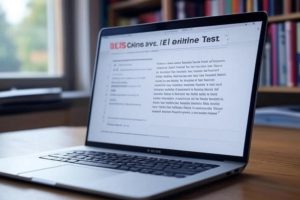The IELTS Reading section often feels like a daunting mountain to climb, especially for first-time test takers. With 40 questions to be answered in just 60 minutes, even fluent English speakers find themselves racing against time. But with the right approach, a solid plan, and a modern test practice platform tailored for the computer-delivered format, you can turn this challenge into a victory.
What is the IELTS Reading Test?
The IELTS Reading test is one of the four main components of the IELTS exam, designed to assess your reading comprehension and ability to extract key information from a variety of texts. Whether you’re aiming for the Academic or General Training version, the structure remains the same: 3 passages and 40 questions, to be completed in 60 minutes—no extra time for transferring answers.
Academic vs General Reading: Know Your Version
The Academic version is tailored for those applying to universities or professional registration, featuring texts from academic journals, textbooks, and research articles. The General Training version, on the other hand, includes materials like advertisements, guidebooks, and workplace manuals. Knowing which test you’re taking is crucial for focused preparation.
Common Topics You Can Expect
IELTS Reading doesn’t expect you to be a subject matter expert, but it does cover a wide range of topics. Common themes include science and technology, history, sociology, environment, health, and education. Familiarizing yourself with these topics through reading newspapers, journals, or practicing on our platform gives you an edge.
Question Types: Beyond Just Multiple Choice
IELTS Reading features over 10 different question types: multiple choice, matching headings, true/false/not given, sentence completion, flowchart labeling, and more. Each type requires a specific strategy. For example, scanning is essential for locating keywords, while skimming helps grasp the main idea quickly.
Timing is Everything
With just 60 minutes to tackle 3 long passages and 40 questions, timing is critical. Ideally, you should spend about 20 minutes per section. But that includes reading the passage, answering questions, and reviewing if possible. On the computer-delivered test, tools like highlighting and copy-pasting can save precious seconds—something you can practice on our digital mock exams.
Why Computer-Delivered IELTS Has an Edge
Let’s be honest: paper-based exams feel outdated. The computer-delivered IELTS offers benefits like on-screen text navigation, faster results (3–5 days), zoom and highlight features, and built-in word counters. It also reduces the risk of poor handwriting or missed answer transfers. However, to get used to the format, you need consistent digital practice—exactly what our platform is designed to deliver.
Common Challenges (And How You Can Beat Them)
Many test-takers struggle with time management, vocabulary, and understanding the difference between similar question types. Our AI-based feedback helps you track your weak areas while offering detailed explanations and strategies after each practice test. You’ll quickly learn where you lose time and how to improve your reading habits.
How IELTS Reading is Scored
Your reading score is based on the number of correct answers out of 40, converted into a band score ranging from 0 to 9. There’s no penalty for wrong answers, so guessing is always better than leaving blanks. Academic and General Training versions are scored slightly differently due to varying difficulty levels, but both are equally important in your final IELTS result.

How Our Practice Platform Gives You the Upper Hand
Our platform replicates the real computer-delivered IELTS environment. From a timer at the top to navigable question panes and interactive text features, you’ll get used to every pixel of the real test. In addition, our algorithm adjusts difficulty based on your performance and tracks your history so you can monitor progress in real time. We offer question banks across various topics and difficulty levels to mimic the real exam’s unpredictability.
Preparation Tips: Get Test-Day Ready
Start by identifying your baseline through a mock test. Then focus on one question type at a time. Build vocabulary by reading daily and writing down new words. Practice scanning and skimming using newspaper articles. And most importantly, simulate test conditions regularly on our platform to build speed and confidence. By test day, reading under time pressure should feel natural, not stressful.
Your Next Step: Practice with Purpose
The IELTS Reading test isn’t just about reading fast—it’s about reading smart. With so much riding on your results, random practice isn’t enough. You need targeted, adaptive practice that helps you understand the format, learn strategies, and manage your time. Our platform has helped thousands of users move from uncertainty to success. Don’t just study—train like it’s the real test. Click below to start your free practice session and see the difference yourself.



